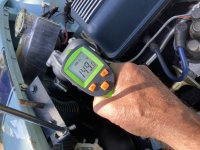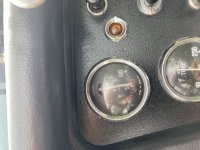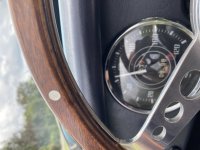Rick_Thompson
Freshman Member
Offline
I have an electric fan conversion I did when installing my rack and pinion conversion.
A few weeks ago while out running, the car began to overheat and literally pegged the new to me temperature gauge I had installed. Original gauge had cracked the capillary tube and I did not send it off for a rebuild as I found this one on Ebay. The gauge stayed at 230 even after the car cooled down. Tapping on it a bit got it to drop back to a normal range. Since that time it doesnt seem to be working properly.
The overheat was from the fan blade disconnecting from the motor. It took a while to fix once I get the car home, but all is good now with a new nut and some red loctite.
Since then, the gauge will run up to around 200 degrees when in normal traffic, it will drop to around 185 when moving in 40-50 mph traffic. I have previously had the car run around 160-170 as I run a 160 degree thermostat.
When hot, I have pulled over, popped the bonnet and using an infrared heat gun pointed directly at the thermostat housing I get a reading close to 175-180. Pointing at the rad I get 170-175. Pointing at the water pump housing I see 175-180.
I feel the gauge was damaged when it was pegged full hot. I am about to pull the gaugeand make an adjustment.
What are your thoughts?

A few weeks ago while out running, the car began to overheat and literally pegged the new to me temperature gauge I had installed. Original gauge had cracked the capillary tube and I did not send it off for a rebuild as I found this one on Ebay. The gauge stayed at 230 even after the car cooled down. Tapping on it a bit got it to drop back to a normal range. Since that time it doesnt seem to be working properly.
The overheat was from the fan blade disconnecting from the motor. It took a while to fix once I get the car home, but all is good now with a new nut and some red loctite.
Since then, the gauge will run up to around 200 degrees when in normal traffic, it will drop to around 185 when moving in 40-50 mph traffic. I have previously had the car run around 160-170 as I run a 160 degree thermostat.
When hot, I have pulled over, popped the bonnet and using an infrared heat gun pointed directly at the thermostat housing I get a reading close to 175-180. Pointing at the rad I get 170-175. Pointing at the water pump housing I see 175-180.
I feel the gauge was damaged when it was pegged full hot. I am about to pull the gaugeand make an adjustment.
What are your thoughts?

 Hi Guest!
Hi Guest!

 smilie in place of the real @
smilie in place of the real @
 Pretty Please - add it to our Events forum(s) and add to the calendar! >>
Pretty Please - add it to our Events forum(s) and add to the calendar! >> 



